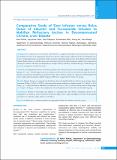Please use this identifier to cite or link to this item:
https://hdl.handle.net/20.500.14356/1272Full metadata record
| DC Field | Value | Language |
|---|---|---|
| dc.contributor.author | Pathak, Rahul | - |
| dc.contributor.author | Yadav, Ajay Kumar | - |
| dc.contributor.author | Thapaliya, Sabin | - |
| dc.contributor.author | Kafle, Brindeshwari | - |
| dc.contributor.author | Jha, Anurag | - |
| dc.contributor.author | Khadga, Prem | - |
| dc.date.accessioned | 2023-05-04T07:01:47Z | - |
| dc.date.available | 2023-05-04T07:01:47Z | - |
| dc.date.issued | 2020 | - |
| dc.identifier.citation | PathakR., YadavA. K., ThapaliyaS., KafleB., JhaA., & KhadgaP. (2020). Comparative Study of Slow Infusion versus Bolus Doses of Albumin and Furosemide Infusion to Mobilize Refractory Ascites in Decompensated Chronic Liver Disease. Journal of Nepal Health Research Council, 18(2), 233-237. https://doi.org/10.33314/jnhrc.v18i2.2116 | en_US |
| dc.identifier.issn | Print ISSN: 1727-5482; Online ISSN: 1999-6217 | - |
| dc.identifier.uri | http://103.69.126.140:8080/handle/20.500.14356/1272 | - |
| dc.description | Original Article | en_US |
| dc.description.abstract | Abstract Background: Combined use of furosemide with albumin is an approved therapy to overcome diuretic resistance in treatment of ascites in decompensated chronic liver disease. Bolus dosing of diuretics has its own limitations due to pre-existing hypotension, post diuretic sodium retention and braking phenomenon. Slow albumin and furosemide Infusion has been shown to mobilize large ascites with improved diuresis and hemodynamic stability in decompensated chronic liver disease. This study was undertaken to compare efficacy and safety of infusion therapy vs bolus therapy in term the management of refractory ascites. Methods: Decompensated chronic liver disease patients with refractory ascites were randomly assigned into two groups of 15 each - Bolus therapy (intravenous albumin and furosemide as boluses) and Infusion therapy (furosemide infusion at 2mg/hour and albumin at 2g/hour for three days). Diuresis, natriuresis, change in abdominal girth and body weight, and hemodynamic stability (change in SBP) were compared between the two groups. Results: Infusion therapy, as compared to bolus therapy, showed a significantly better diuresis (mean urinary output increment 483ml vs 243ml, p <0.001), natriuresis (mean urinary sodium excretion increment 35.2 mEq/L vs 16.6 mEq/L, p = 0.004),decrease in abdominal circumference (6.1cm vs 3.0cm, p<0.001) and decrease in body weight (5.53 Kg vs 2.86 Kg, p < 0.001). The complications of renal impairment were also lower in the Infusion group. Conclusion: Infusion of furosemide and albumin is a potential safer and effective therapeutic option in the management of refractory ascites with better natriuresis, higher urine output, and higher decrement in abdominal circumference and body weight, and lesser side effects. Keywords: Bolus dose; continuous infusion; decompensated chronic liver disease; refractory ascites. | en_US |
| dc.language.iso | en | en_US |
| dc.publisher | Nepal Health Research Council | en_US |
| dc.relation.ispartofseries | Apr-June, 2020;2116 | - |
| dc.subject | Bolus dose | en_US |
| dc.subject | continuous infusion | en_US |
| dc.subject | decompensated chronic liver disease | en_US |
| dc.subject | refractory ascites | en_US |
| dc.title | Comparative Study of Slow Infusion versus Bolus Doses of Albumin and Furosemide Infusion to Mobilize Refractory Ascites in Decompensated Chronic Liver Disease | en_US |
| dc.type | Journal Article | en_US |
| local.journal.category | Original Article | - |
| Appears in Collections: | Vol. 18 No. 2 Issue 47 Apr-Jun 2020 | |
Files in This Item:
| File | Description | Size | Format | |
|---|---|---|---|---|
| 2116-Manuscript-17522-1-10-20200911.pdf | Fulltext Download | 228.64 kB | Adobe PDF |  View/Open |
Items in DSpace are protected by copyright, with all rights reserved, unless otherwise indicated.
